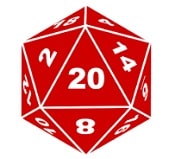In order to know the meaning of the term icosahedron, it is necessary, first of all, to discover its etymological origin. In this case, we can emphasize that it derives from Latin, specifically from the word "icosahedrum" which, in turn, comes from Greek. Exactly it emanates from the Greek "eikosaedron", which can be translated as "twenty-sided".
Likewise, we have to establish that this Greek word is the result of the sum of two components of said language:
-The term "eikosas", which means "twenty."
-The word "hedra", which is synonymous with "surface", "face" or "sitting surface".
This term is used in the field of geometry to refer to a solid that has twenty faces .
 A solid is a body : that is, a three-dimensional object. Faces, on the other hand, are the various surfaces that make up solids. In the case of icosahedrons, they are specifically polyhedra , since they are solids delimited by flat surfaces.
A solid is a body : that is, a three-dimensional object. Faces, on the other hand, are the various surfaces that make up solids. In the case of icosahedrons, they are specifically polyhedra , since they are solids delimited by flat surfaces.
Icosahedra can be concave or convex . When the icosahedron has twenty faces that are equal triangles , congruent and equilateral , it is regular and convex .
A regular icosahedron , in turn, is a Platonic solid . This qualification is given to those convex polyhedra whose faces are equal and regular polygons, and which also have all their solid angles equal. The cube , tetrahedron , octahedron and dodecahedron are, like the regular icosahedron, Platonic solids.
In order to calculate the area of an icosahedron, we must start from the length of the edge. Thus, knowing this, the formula will be the following: 5. √3. a2.
If what you want, on the other hand, is to be able to calculate the volume of the icosahedron in question, what you will have to do is follow this formula: 5/12 (3 + √5) a3.
In addition to all of the above, we cannot forget that there is also what is called the Great Icosahedron. This, which is made up of a total of twenty crossed triangular faces, is one of the Kepler-Poinsot polyhedra. Polyhedra that are regular, not convex, that have the same number of faces at all their vertices and that these faces become regular polygons.
There are exactly four Kepler-Poinsot polyhedra. Thus, in addition to the Great Icosahedron, there are the Great Dodecahedron, the Small stellated dodecahedron and the Great stellated dodecahedron.
It is possible to find icosahedrons in different contexts. Since the time of the Roman Empire , for example, twenty-sided dice have existed. These icosahedrons are currently used in war games and role-playing games.
Viruses of the Herperviridae family, meanwhile, have an icosahedron structure. This shape allows them to assemble the protein units that compose them in a simple way. Some radiolarians , which are protists that group together as zooplankton, also have the shape of an icosahedron.
Soccer balls , finally, are usually truncated icosahedrons (since the vertices are cut), made up of twenty leather pentagons or hexagons. When the ball is inflated, it becomes spherical.
